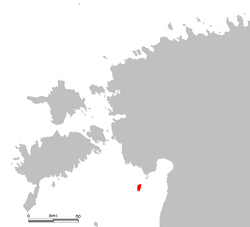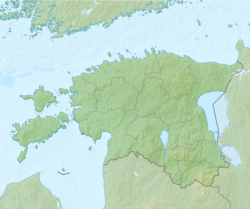Kihnu
This articleneeds additional citations forverification.(May 2023) |
Kihnu
Kihnu Kynö | |
|---|---|
Island | |
 Gulf of Riga, with Kihnu and other islands | |
| Coordinates:58°07′48″N23°59′24″E/ 58.13000°N 23.99000°E | |
| Country | |
| Region | Pärnu County |
| Municipality | Kihnu Parish |
| Area | |
| • Total | 16.38 km2(6.32 sq mi) |
| Elevation | 29.6 m (97.1 ft) |
| Population (2013) | |
| • Total | 690 |
| • Density | 42/km2(110/sq mi) |
| Time zone | UTC+2(EET) |
| • Summer (DST) | UTC+3(EEST) |
| Postal codes | 88005 |
Kihnuis an island in theBaltic Sea.With an area of 16.4 km2(6.3 sq mi), it is the largest island in theGulf of Riga[2]and the seventh largest island ofEstonia.With a length of 7 km (4.3 mi) and width of 3.3 km (2.1 mi), the island's highest point is 8.9 metres (29.2 ft)above sea level.
Kihnu falls intoPärnu Countyand together with neighbouring islands formsKihnu Parish,one of the smallestmunicipalitiesof the country, with an area of 16.8 km2(6.5 sq mi).
604 people lived on Kihnu as of 2007[update],69 of whom were primary school pupils. There are four villages:Lemsi,Linaküla,Rootsiküla,andSääre.One can reach Kihnu by a fifteen-minute plane trip fromPärnuor by ferry, with trips taking three hours from Pärnu and one fromManilaid.When the sea is frozen in winter, it is possible to drive to the islandover the ice.
The nearby isle ofManilaid(or Manija,Manõjain the Kihnu dialect) has been inhabited by people from Kihnu since 1933 and thus shares its culture.
UNESCOproclaimed Kihnu's cultural space and traditions as aMasterpiece of the Oral and Intangible Heritage of Humanityon 7 November 2003.[3][4]
Kihnu is also calledKihnumuain thelocal dialect.Names in other languages includeĶīļuin Latvian,Kynöin Standard Swedish,KininEstonian Swedish,and historically,Kühnöin German. InEstonian Sign Language,the island is signed by imitating the vertical stripes of a Kihnu skirt. There are various theories on the etymology of the name Kihnu, with no consensus. The earliest recorded version of the name isKyne,from 1386.[5]
Culture[edit]
As the men of Kihnu have been frequently away at sea, women have run everyday life on the island and became the guardians of the island's cultural heritage, which includeshandicrafts,dances, games, and music. The latter is an especially important part of the island's traditions and accompanies handicrafts, religious feasts, and other celebrations. Ancientruno-styled songs are also important, as is traditional clothing adorned with decorations and bright colours. There are elaborate wedding traditions, which are considered the "most complex and bright expression" of Kihnu culture.[6]
Kihnu is known for its handicrafts and distinctive traditional clothing, which is still commonly worn today. It includes striped skirts (kört), patternedknitmen's sweaters (troi), and knit mittens. Young women have traditionally organised evening get-togethers (ülalistmine,i.e., "sitting (staying) up (late)" ) to do handicrafts.
Traditional cuisine includesrye breadwith potatoes, pork fat, orBaltic herringadded to the dough;eelsoup, prepared by fishers; and sweet milk soup, an important dish at weddings.[7]Seal huntingis practiced in Kihnu, and themeatis considered a delicacy. Another distinctive delicacy is the eggs of semi-domesticatedmergansers(waterbirds), also used for baking cakes.[citation needed]
In the 19th and early 20th centuries, numerous men from Kihnu became sailors. The most famous of them was the largely self-taught captainEnn Uuetoa,also known asKihnu Jõnn(1848 – 1913;Jõnnis the local pronunciation of the name Enn).
Language[edit]
TheKihnu dialectis thought to belong to theinsular dialect groupofNorth Estonian,along with the dialects ofSaaremaa,Muhu,andHiiumaa.It is unusual among North Estonian dialects in preservingvowel harmony,like most otherFinnic languages.The dialect includestriphthongs.There areSwedishinfluences in vocabulary andintonation.
Geography and climate[edit]
The island has a sandy interior and arocky coastmade up of more than fifty islets, which are an important nesting ground for birds. Along thedunes,beach ridges,and sands of the eastern part, the island reaches its maximum height of 29.6 m above sea level.[1]
| Climate data for Kihnu (normals 1991–2020, extremes 1931–present) | |||||||||||||
|---|---|---|---|---|---|---|---|---|---|---|---|---|---|
| Month | Jan | Feb | Mar | Apr | May | Jun | Jul | Aug | Sep | Oct | Nov | Dec | Year |
| Record high °C (°F) | 8.1 (46.6) |
6.4 (43.5) |
17.2 (63.0) |
23.9 (75.0) |
29.3 (84.7) |
31.4 (88.5) |
31.8 (89.2) |
31.7 (89.1) |
26.6 (79.9) |
19.3 (66.7) |
12.8 (55.0) |
9.3 (48.7) |
31.8 (89.2) |
| Mean daily maximum °C (°F) | 0.0 (32.0) |
−1.0 (30.2) |
1.8 (35.2) |
7.6 (45.7) |
14.0 (57.2) |
18.1 (64.6) |
21.3 (70.3) |
20.7 (69.3) |
16.1 (61.0) |
10.2 (50.4) |
5.4 (41.7) |
2.3 (36.1) |
9.7 (49.5) |
| Daily mean °C (°F) | −1.7 (28.9) |
−2.9 (26.8) |
−0.5 (31.1) |
4.5 (40.1) |
10.5 (50.9) |
14.9 (58.8) |
18.3 (64.9) |
18.0 (64.4) |
13.8 (56.8) |
8.3 (46.9) |
3.8 (38.8) |
0.8 (33.4) |
7.3 (45.1) |
| Mean daily minimum °C (°F) | −3.6 (25.5) |
−4.9 (23.2) |
−2.7 (27.1) |
2.1 (35.8) |
7.7 (45.9) |
12.3 (54.1) |
15.6 (60.1) |
15.4 (59.7) |
11.5 (52.7) |
6.4 (43.5) |
2.1 (35.8) |
−1.0 (30.2) |
5.1 (41.2) |
| Record low °C (°F) | −32.4 (−26.3) |
−30.8 (−23.4) |
−22.6 (−8.7) |
−15.7 (3.7) |
−2.0 (28.4) |
3.2 (37.8) |
7.1 (44.8) |
6.1 (43.0) |
0.6 (33.1) |
−5.5 (22.1) |
−14.5 (5.9) |
−29.5 (−21.1) |
−32.4 (−26.3) |
| Averageprecipitationmm (inches) | 42 (1.7) |
35 (1.4) |
33 (1.3) |
33 (1.3) |
36 (1.4) |
59 (2.3) |
62 (2.4) |
66 (2.6) |
54 (2.1) |
67 (2.6) |
57 (2.2) |
52 (2.0) |
595 (23.4) |
| Average precipitation days(≥ 1.0 mm) | 10.3 | 8.3 | 7.9 | 7.1 | 7.0 | 8.3 | 7.6 | 8.6 | 8.9 | 11.2 | 11.3 | 11.6 | 108.1 |
| Averagerelative humidity(%) | 88 | 88 | 85 | 80 | 77 | 80 | 79 | 79 | 81 | 83 | 86 | 87 | 83 |
| Source 1:Estonian Weather Service[8][9][10][11][12] | |||||||||||||
| Source 2:NOAA/NCEI(average precipitation days 1991-2020)[13] | |||||||||||||
Images[edit]
-
Church
-
An inn
-
Seashore
-
Museum
-
Village road
-
Garden
-
A view of the coastline
-
Young girls in both modern and traditional dress returning from school.
-
Pine forest
-
Cemetery
-
An adult grey seal on drift ice just off of the Kihnu coast.
See also[edit]
References[edit]
- ^ab"The islands in the Väinameri Sea and the Gulf of Riga".Estonica.Eesti Instituut.28 September 2012. Archived fromthe originalon 15 August 2016.Retrieved20 February2018.
- ^C.Michael Hogan. 2011.Gulf of Riga.Encyclopedia of Earth. Eds. P.Saundry & C.J.Cleveland. National Council for Science and the Environment. Washington DC.
- ^"Kihnu cultural space – intangible heritage".UNESCO.
- ^"Beyond Tallinn: Stunning Places to Visit in Estonia You Never Knew Existed – Europe Guidebook".4 February 2023.Retrieved7 April2023.
- ^Dictionary of Estonian Place names.
- ^"Kihnu wedding".Kihnu Cultural Space.Retrieved23 July2020.
- ^"Food".Kihnu Cultural Space.Retrieved23 July2020.
- ^ "Climate normals-temperature".Estonian Weather Service. Archived fromthe originalon 17 April 2024.Retrieved14 February2021.
- ^ "Climate normals-precipitation".Estonian Weather Service. Archived fromthe originalon 17 April 2024.Retrieved14 February2021.
- ^ "Climate normals-humidity".Estonian Weather Service. Archived fromthe originalon 17 April 2024.Retrieved14 February2021.
- ^ "Kliimanormid-Sademed, õhuniiskus"(in Estonian). Estonian Weather Service. Archived fromthe originalon 22 February 2012.Retrieved14 February2021.
- ^ "Rekordid"(in Estonian). Estonian Weather Service. Archived fromthe originalon 17 April 2024.Retrieved19 March2021.
- ^"Kihnu climate normals 1991–2020".NOAA.Archived fromthe originalon 17 April 2024.
















